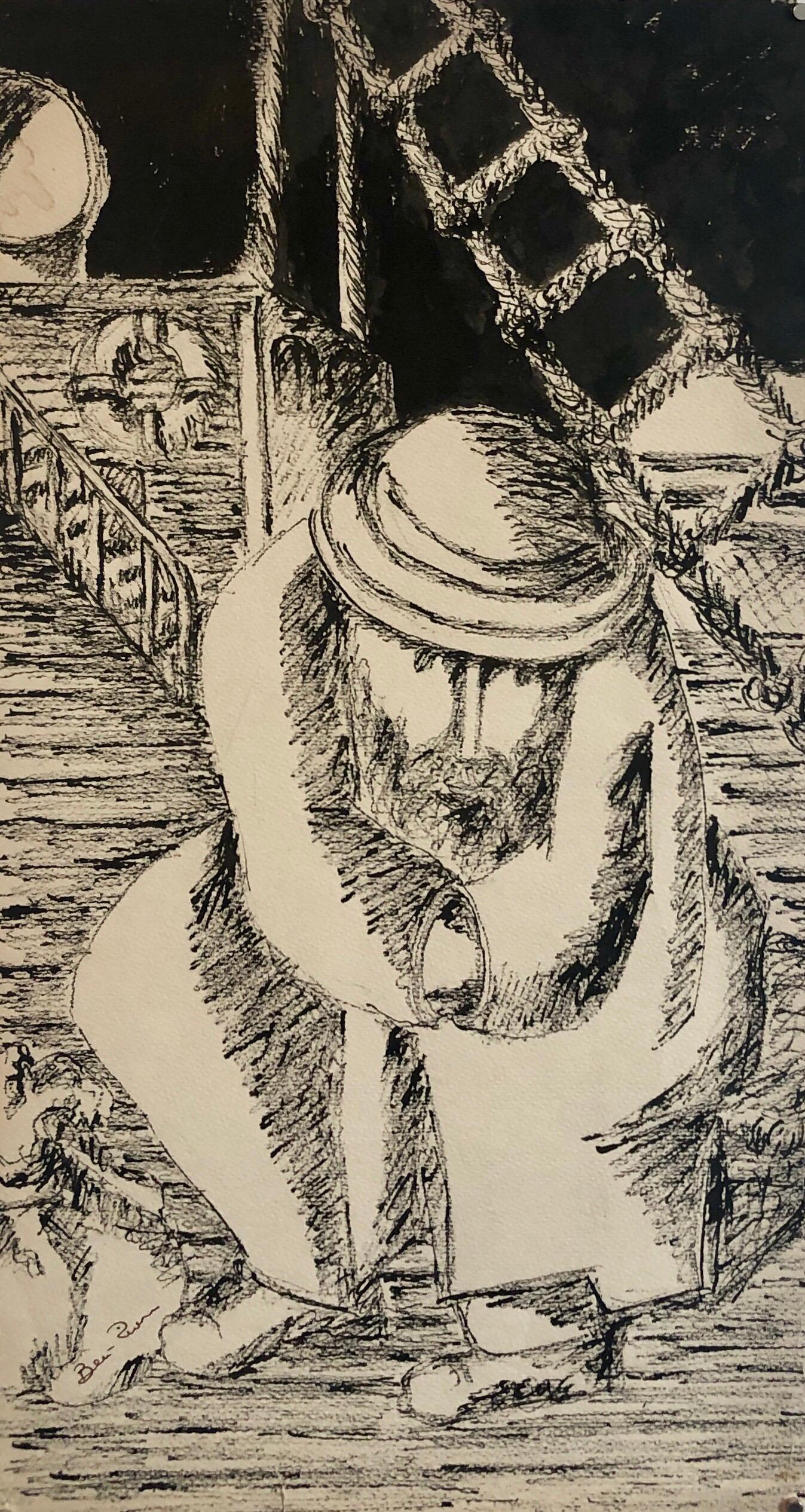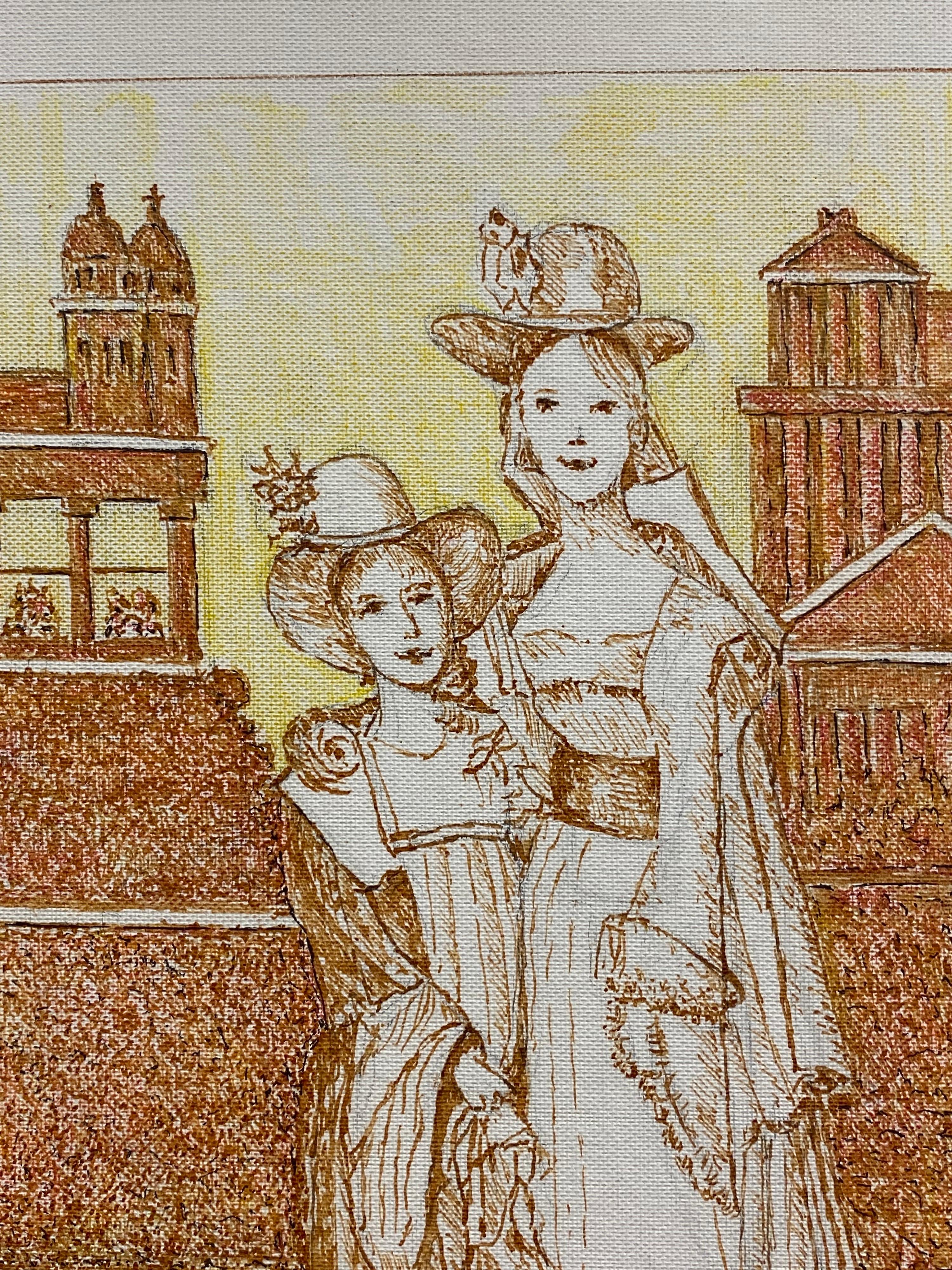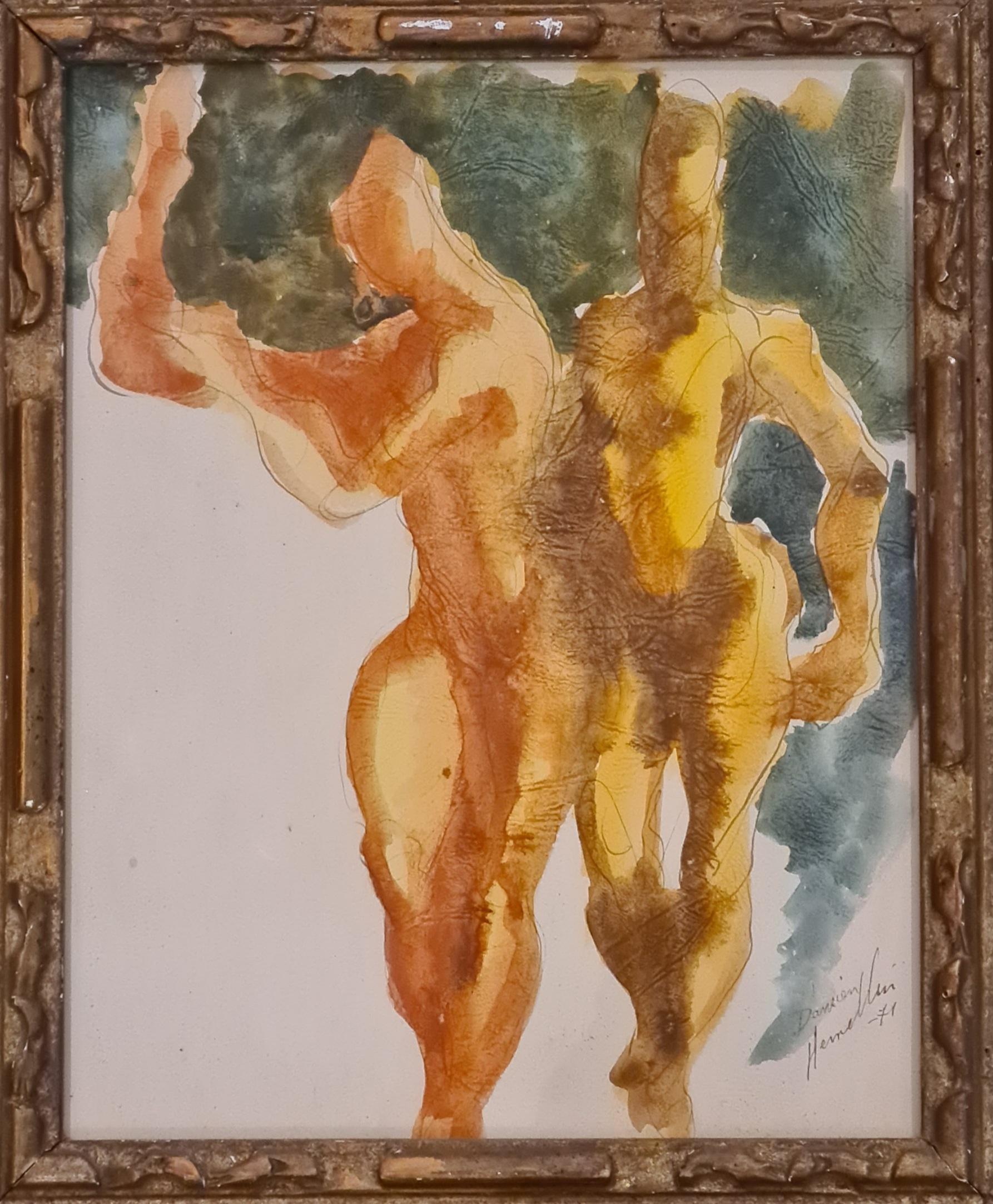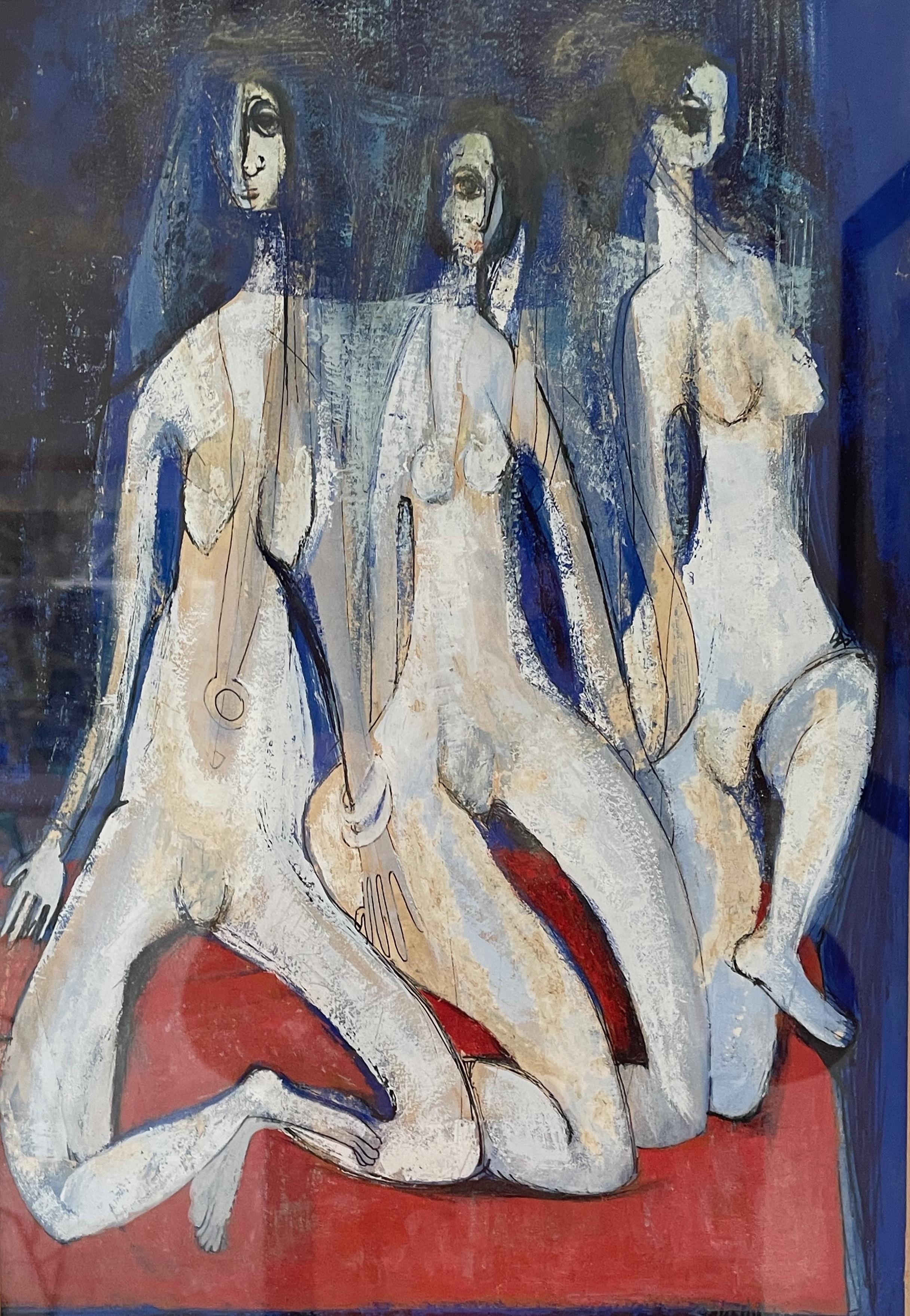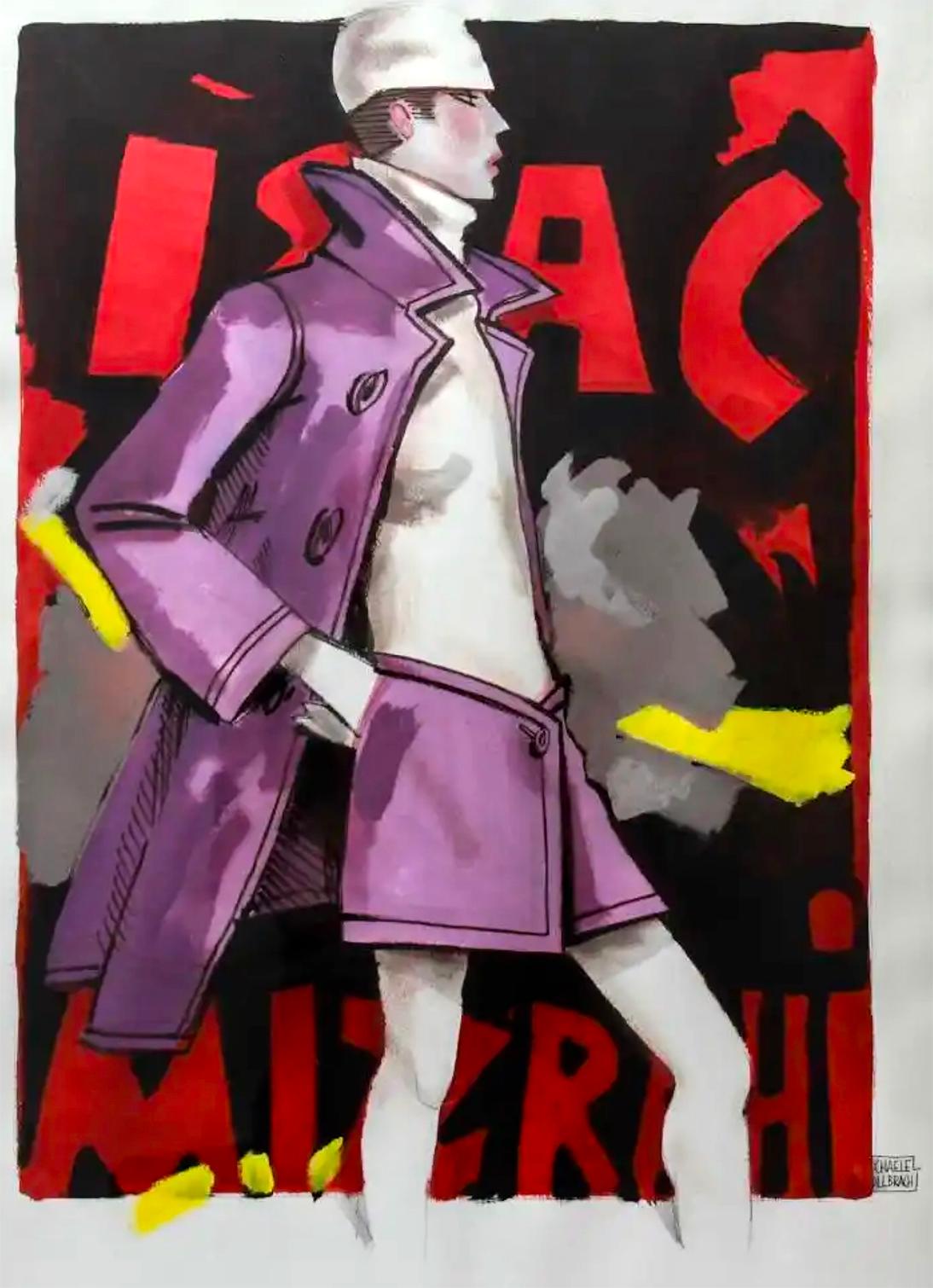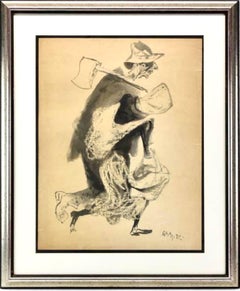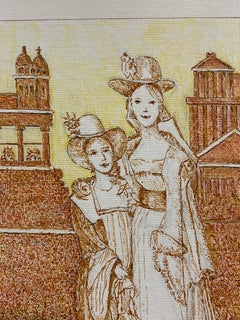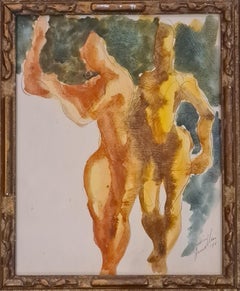
Rabbis Dancing, Israeli Judaica Gouache Painting
View Similar Items
Want more images or videos?
Request additional images or videos from the seller
1 of 9
David GilboaRabbis Dancing, Israeli Judaica Gouache Paintingc.1950
c.1950
About the Item
- Creator:David Gilboa (1910 - 1976)
- Creation Year:c.1950
- Dimensions:Height: 20.5 in (52.07 cm)Width: 15.75 in (40.01 cm)
- Medium:
- Movement & Style:
- Period:
- Condition:back of board a bit rough. it is unframed.
- Gallery Location:Surfside, FL
- Reference Number:1stDibs: LU3823230363
About the Seller
4.9
Platinum Seller
These expertly vetted sellers are 1stDibs' most experienced sellers and are rated highest by our customers.
Established in 1995
1stDibs seller since 2014
1,555 sales on 1stDibs
Typical response time: 1 hour
More From This SellerView All
- Americana Farmer and Wife, Gouache Painting WPA Art William Gropper WoodchopperBy William GropperLocated in Surfside, FLWilliam Gropper Original Gouache on Paper depicting man carrying an axe and woman carrying basket walking together. Hand signed lower right Fra...Category
Mid-20th Century Modern Figurative Paintings
MaterialsInk, Watercolor, Gouache
- Chicago Jewish Modernist Judaica Painting Simchat Torah WPA Artist Israeli FlagsBy Alexander Raymond KatzLocated in Surfside, FLThis has young ISraeli pioneers dancing with the flag as typical of works of the late British mandate Palestine era early state of Israel. Genre: Modern Subject: Figurative (stained glass style) Medium: Mixed media gouache on paper Hand signed lower left Alexander Raymond Katz, Hungarian / American (1895 – 1974) Alexander Raymond Katz was born in Kassa, Hungary, and came to the United States in 1909. He studied at the Art Institute of Chicago and the Chicago Academy of Fine Arts. In the late 1920s, he worked as a director of the Poster Department at Paramount Studios. He was appointed the Director of Posters for the Chicago Civic Opera in 1930. During the Great Depression, notable architect Frank Lloyd Wright urged Katz to become a muralist. In 1933, he was commissioned to paint a mural for the Century of Progress exposition in Chicago. In 1936, he painted the mural History of the Immigrant for the Madison, Ill., post office. Katz’s works were included in various exhibitions and now are part of several museum collections, including those of the Art Institute of Chicago; Corcoran Gallery of Art, Washington, D.C.; and the Jewish Museum, New York. His murals, bas-reliefs and stained glass designs adorn more than 200 Jewish synagogues in the United States. Katz and other Jewish artists in Chicago who expressed Jewish and Biblical themes were inspired by the artist Abel Pann (1883-1963). Pann, who is regarded as the leading painter of the Land of Israel, exhibited in the Art Institute of Chicago in 1920. Early in his career, Katz began to explore the artistic possibilities inherent in the characters of the Hebrew alphabet. He developed aesthetic and philosophical interpretations of each letter and became the leading innovator and pioneer in the field of Hebraic art. Katz applies this concept in the woodcut Moses and the Burning Bush. Hebrew letters appears in Moses’ head, his cane and inside the flame. The initial of Moses’ name crowns his head. The letter in the flame is the first letter of the name of God. A combination of images and Hebrew letters appeared commonly in illustrations of the scene Moses and the Burning Bush in the Haggadah, the book of Passover. The symbolism of the burning bush corresponds to the motifs of A Gift to Biro-Bidjan. Among the fourteen participating artists were notable Chicago modernists Todros Geller, Mitchell Siporin...Category
Mid-20th Century Modern Figurative Paintings
MaterialsPaper, Gouache
- Rare Modernist Hungarian Rabbi Pastel Drawing Gouache Painting Judaica Art DecoBy Hugó ScheiberLocated in Surfside, FLRabbi in the synagogue at prayer wearing tallit and tefillin. Hugó Scheiber (born 29 September 1873 in Budapest – died there 7 March 1950) was a Hungarian modernist painter. Hugo Scheiber was brought from Budapest to Vienna at the age of eight where his father worked as a sign painter for the Prater Theater. At fifteen, he returned with his family to Budapest and began working during the day to help support them and attending painting classes at the School of Design in the evening, where Henrik Papp was one of his teachers. He completed his studies in 1900. His work was at first in a post-Impressionistic style but from 1910 onward showed his increasing interest in German Expressionism and Futurism. This made it of little interest to the conservative Hungarian art establishment. However, in 1915 he met the great Italian avant-gardist Filippo Tommaso Marinetti and the two painters became close friends. Marinetti invited him to join the Futurist Movement. The uniquely modernist style that he developed was, however, closer to German Expressionism than to Futurism and eventually drifted toward an international art deco manner similar to Erté's. In 1919, he and his friend Béla Kádar held an exhibition at the Hevesy Salon in Vienna. It was a great success and at last caused the Budapest Art Museum to acquire some of Scheiber's drawings. Encouraged, Scheiber came back to live in Vienna in 1920. A turning point in Scheiber's career came a year later, when Herwarth Walden, founder of Germany's leading avant-garde periodical, Der Sturm, and of the Sturm Gallery in Berlin, became interested in Scheiber's work. Scheiber moved to Berlin in 1922, and his paintings soon appeared regularly in Walden's magazine and elsewhere. Exhibitions of his work followed in London, Rome, La Paz, and New York. Scheiber's move to Germany coincided with a significant exodus of Hungarian artists to Berlin, including Laszlo Moholy-Nagy and Sandor Bortnyik. There had been a major split in ideology among the Hungarian avant-garde. The Constructivist and leader of the Hungarian avantgarde, Lajos Kassák (painted by Hugó Scheiber in 1930) believed that art should relate to all the needs of contemporary humankind. Thus he refused to compromise the purity of his style to reflect the demands of either the ruling class or socialists and communists. The other camp believed that an artist should be a figurehead for social and political change. The fall out and factions that resulted from this politicisation resulted in most of the Hungarian avant gardists leaving Vienna for Berlin. Hungarian émigrés made up one of the largest minority groups in the German capital and the influx of their painters had a significant effect on Hungarian and international art. Another turning point of Scheiber's career came in 1926, with the New York exhibition of the Société Anonyme, organized by Katherine Dreier. Scheiber and other important avant garde artists from more than twenty-three countries were represented. In 1933, Scheiber was invited by Marinetti to participate in the great meeting of the Futurists held in Rome in late April 1933, Mostra Nazionale d’Arte Futurista where he was received with great enthusiasm. Gradually, the Hungarian artists began to return home, particularly with the rise of Nazism in Germany. Kádar went back from Berlin in about 1932 and Scheiber followed in 1934. He was then at the peak of his powers and had a special flair in depicting café and cabaret life in vivid colors, sturdily abstracted forms and spontaneous brush strokes. Scheiber depicted cosmopolitan modern life using stylized shapes and expressive colors. His preferred subjects were cabaret and street scenes, jazz musicians, flappers, and a series of self-portraits (usually with a cigar). his principal media being gouache and oil. He was a member of the prestigious New Society of Artists (KUT—Képzőművészek Új Társasága)and seems to have weathered Hungary's post–World War II transition to state-communism without difficulty. He continued to be well regarded, eventually even receiving the posthumous honor of having one of his images used for a Russian Soviet postage stamp (see image above). Hugó Scheiber died in Budapest in 1950. Paintings by Hugó Scheiber form part of permanent museum collections in Budapest (Hungarian National Museum), Pecs (Jannus Pannonius Museum), Vienna, New York, Bern and elsewhere. His work has also been shown in many important exhibitions, including: "The Nell Walden Collection," Kunsthaus Zürich (1945) "Collection of the Société Anonyme," Yale University Art Gallery, New Haven, Connecticut (1950) "Hugó Scheiber: A Commemorative Exhibition," Hungarian National Museum, Budapest (1964) "Ungarische Avantgarde," Galleria del Levante, Munich (1971) "Paris-Berlin 1900-1930," Centre Georges Pompidou, Paris (1978) "L’Art en Hongrie, 1905-1920," Musée d’Art et l’Industrie, Saint-Etienne (1980) "Ungarische Avantgarde in der Weimarer Republik," Marburg (1986) "Modernizmus," Eresz & Maklary Gallery, Budapest (2006) "Hugó Scheiber & Béla Kádár," Galerie le Minotaure, Paris and Tel Aviv (2007) Hugó Scheiber's paintings continue to be regularly sold at Sotheby's, Christie's, Gillen's Arts (London), Papillon Gallery (Los Angeles) and other auction houses. He was included in the exhibition The Art Of Modern Hungary 1931 and other exhibitions along with Vilmos Novak Aba, Count Julius Batthyany, Pal Bor, Bela Buky, Denes Csanky, Istvan Csok, Bela Czobel, Peter Di Gabor, Bela Ivanyi Grunwald, Baron Ferenc Hatvany, Lipot Herman, Odon Marffy, C. Pal Molnar...Category
Early 20th Century Modern Figurative Paintings
MaterialsPaper, Charcoal, Pastel, Watercolor, Gouache
- Americana, Lawyer in Court, Politician, Gouache Painting WPA Art William GropperBy William GropperLocated in Surfside, FLWilliam Gropper Original Gouache on Paper Hand signed lower right 33.5 x 27.5 image 26 x 20.5 The New-York born artist William Gropper was a painter and cartoonist who, with caricature style, focused on social concerns, and was actively engaged in support of the organized labor movement throughout his career. This original watercolor drawing is done in the iconic style of the artist's oeuvre. Born to Harry and Jenny Gropper in 1897, William was raised in New York City's Lower East Side. His parents were Jewish immigrants from Romania and Ukraine, and young William grew up in relative poverty, watching his family struggle to achieve that sought-after American dream. His father, a bright and college-educated man, was unable to find employment that worthy of his intellect. His mother, meanwhile, worked as a seamstress from home. Coupled with the devastating loss of an aunt to the infamous Triangle Factory fire of 1911, significant childhood factors created the foundation that led to Gropper’s exploration of the American experience. Early on, Gropper displayed an extraordinary, natural skill for art. By 1912, he was already studying under the instruction of George Bellows and Robert Henri at the Ferrer School in Greenwich Village. During his time at school, Gropper was also awarded a prestigious scholarship to study at the National Academy of Design. However, he refused to fit into convention and was swiftly expelled from the Academy. After his expulsion, Gropper returned home to help financially by assisting his mother and taking a shop position. However, he didn't abandon art academia and soon presented a portfolio to the New York School of Fine Art which earned him a scholarship for study. Gropper obtained his first significant job as a cartoonist for the New York Tribune in 1917. While working as a staff cartoonist for the Tribune, he also contributed drawings to publications like Vanity Fair, New Masses, The Nation, and Freiheit. His interest in the welfare of the American worker, class inequality, and social injustice was central in his work. After publishing the graphic novel Alley Oop in 1930, Gropper's illustration career extended well into the decade. However, he was never exempt from controversy, and his 1935 Vanity Fair cartoon; prompted anger from the Japanese government. As an involved labor organizer and Social Realist activist, Gropper continued to bring attention to his radical reputation with visits to the Soviet Union and Poland. However, his concern with European politics and U.S. social causes didn't slow down his artistic career, and by the late 1930s, he had produced significant murals for American cities like Washington D.C. His 1938 mural Construction of a Dam was commissioned for the Department of the Interior and represents the Social-Realism style that depicts experiences of the worker and everyday societal life. Measuring at a staggering 27ft by 87ft, the piece portrays muscular, robust American laborers scaling rocky hillsides, building infrastructure, and operating heavy machinery. The mural feels undeniably American with golden scenery, denim blues, and steely gray colors. Gropper fits perfectly into Social-Realism because the style exhibits an illustrative flair with strong lines and simple, bold hues. The inspiration for Construction of a Dam sprang from his 1937 travels to the poverty-stricken Dust Bowl area. The trip was sponsored by a Guggenheim Foundation Fellowship, and his drawings of the Grand Coulee and Boulder Dams...Category
Mid-20th Century Modern Figurative Paintings
MaterialsInk, Watercolor, Gouache
- Modernist Judaica Jewish Ink Drawing Painting "New Immigrant" Off the Boat WPABy Ben-Zion WeinmanLocated in Surfside, FLAn ink drawing Judaic painting by modern artist Ben-Zion Weinman. It depicts a portrait of an old Jewish man. Coming over from Europe on a ship crossing. The work is signed "Ben-Zion". Born in 1897, Ben-Zion Weinman celebrated his European Jewish heritage in his visual works as a sculptor, painter, and printmaker. Influenced by Spinoza, Knut Hamsun, and Wladyslaw Reymont, as well as Hebrew literature, Ben-Zion wrote poetry and essays that, like his visual work, attempt to reveal the deep “connection between man and the divine, and between man and earth.” An emigrant from the Ukraine, he came to the US in 1920. He wrote fairy tales and poems in Hebrew under the name Benzion Weinman, but when he began painting he dropped his last name and hyphenated his first, saying an artist needed only one name. In 1920 he settled in America, where he found little interest in his writing. He began teaching Hebrew to support himself and then in the early 1930s returned to painting. He used his art to comment on the rise of fascism in Europe, events he felt could not be adequately explored with words. Largely self-taught, Ben-Zion visited the museums of New York City to learn his new trade. His first painting on a large scale, Friday Evening (1933, Jewish Museum, New York), depicts a Sabbath dinner table as recalled from his family home. Ben-Zion supported himself by working odd jobs until the establishment of the Works Progress Administration's Federal Art Project. Under the auspices of the wpa, Ben-Zion thrived and galleries began to show his work. In 1936, after his first one-man show at the Artists' Gallery in New York Ben-Zion was a founding member of “The Ten: An Independent Group” The Ten” a 1930’s...Category
1940s American Modern Figurative Paintings
MaterialsWatercolor, Gouache
- Simka Simkhovitch WPA W/C Painting Gouache American Modernist Beach Scene NudeBy Simka SimkhovitchLocated in Surfside, FLSimka Simkhovitch (Russian/American 1893 - 1949) This came with a small grouping from the artist's family, some were hand signed some were not. These were studies for larger paintings. This is a watercolor and gouache beach scene three young men bathing...Category
1930s American Modern Nude Paintings
MaterialsWatercolor, Gouache, Board
You May Also LikeView All
- Classical French Figures in City -1950's French Modernist Cubist Painting signedBy Bernard LabbeLocated in Cirencester, GloucestershireClassical Figures by Bernard Labbe (French mid 20th century) signed original watercolour/ gouache painting on paper board, unframed size: 13 x 9.25 inches condition: very good and re...Category
Mid-20th Century Modern Figurative Paintings
MaterialsWatercolor, Ink, Gouache
- The Dancers, French Late Mid Century Gouache on Textured PaperLocated in Cotignac, FRLate Mid Century French watercolour and Gouache on handmade paper of a pair of dancers by Damien Hermellin. Signed and dated bottom right. Pres...Category
1970s Modern Figurative Drawings and Watercolors
MaterialsWatercolor, Paper, Gouache, Handmade Paper
- Composition With Figures. Figurative Gouache PaintingLocated in Brecon, PowysExcellent work from this Indian Born (1930) artist, who moved to South Africa. She has received International critical aclaim and her work rarely reaches the market Reddy’s style of...Category
1970s Modern Figurative Drawings and Watercolors
MaterialsGouache
- Face, 2003 - gouache, 31x23 cm., framedBy Mas JeanLocated in Nice, FRGouache on paper. FramedCategory
Late 20th Century Modern Figurative Drawings and Watercolors
MaterialsGouache
- Issac Mizrahi illustrationBy Michaele VollbrachtLocated in Miami, FLIssac Mizrahi fashion illustrationon Arches paper signed in ink lower right Circa 1990's Image 29.5" H x 21.25" Frame: 31.5" H x 23.75" W x 1.5" D. Th...Category
1990s Modern Figurative Paintings
MaterialsGouache, Watercolor, Pencil
- 1950s "Mark" Oil Pastel and Gouache Figurative Painting NYC Modern Mid CenturyBy Donald StacyLocated in Arp, TXDonald Stacy "Mark" c.1950s Oil pastel and gouache paint on paper 14x17" unframed Unsigned Came from artist's estate Donald Stacy (1925-2011) New Jersey Studied: Newark School of ...Category
Mid-20th Century Modern Figurative Paintings
MaterialsGouache, Paper, Oil Pastel
Recently Viewed
View AllMore Ways To Browse
Blum Israel
Robert Louis Stevenson
Painting By Yohanan Simon
Rabbis Dancing
Dancing Rabbis Painting
Richard Berger
Paper Boat Painting
Boat Watercolors
Watercolour Boat
Botanical Watercolor
Botanical Watercolour
Watercolor Paintings Valleys
Vintage Gold Framed Drawing
Watercolor Forest
Watercolor Lake
Original Landscape Pencil Drawings
Costume Watercolor
Vintage Siena
